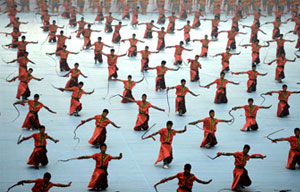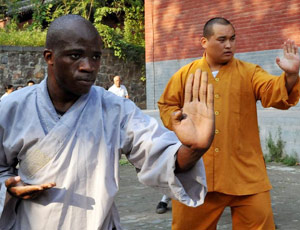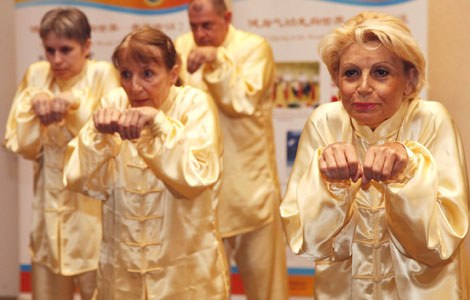
The Ninth Shaolin International Martial Arts Festival kicks off in Zhengzhou, Central China's Henan province, on Sunday.
The 13-style Tai Chi has 13 routines and 60 postures in all. It is believed to be the authentic Tai Chi Chuan handed down by Master Zhang Sanfeng. it contains five steps and eight positions, and it is called Tai Chi Mu Boxing.
XuanMen Sword Play: 74 postures in all. Shaolin enjoys its fame of cudgel manipulation for a long history, while wudang gains its popularity for its internal Kungfu and sword. Sword plays a very special role in Chinese martial arts, and it is considered as "King of Weapons".
A famous saying uses the phrase "Wudang Sword and Shaolin Cudgel". Wudang is famous for its swords. Swords plays a very special role in Chinese weapons.
This weapon derives from the posture of the eight immortals and combines features from wudang kung fu. Form and will are both contained in the simple but practical movements. The technique is also a combination of vigor and suppleness.
The Fu Chen or Horse-Tail Whisk is a characteristic weapon of Taoist kung fu. In ancient times when a Taoist disciple was ready to leave the temple, the Fu Chen was one of the three gifts that a Taoist master would give to his disciple as a reminder of their faith and beliefs.

African apprentices practise kungfu at the Shaolin Temple on the Songshan Mountain in Dengfeng city, Central China's Henan province, Sept 4, 2012.

Courses that aim to train European coaches of the art of Qigong started on Aug 21 in Brussels the capital of Belgium. 83 participants from 17 European countries, that are from 31 qigong organizations will receive training in the disciplines of Chinese health qigong and then they will take duan examinations.
Yin and Yang, which come from ancient Chinese philosophy, are a general term for two opposites of interrelated things or phenomena in the natural world.
Tai Ji pursues the laws of motion and quiescence and takes advantages of the wisdom of the changes of voidness and reality in actions.
Qigong is one of the four pillars of traditional Chinese medicine: Acupuncture, Massage, Herbal Medicines and Qigong. It is an ancient Chinese health care system that integrates physical postures, breathing techniques and focused intention.
By the opposition between Yin and Yang is meant that all things or phenomena in nature have two opposite aspects-Yin and Yang, such as heaven and earth, motion and quiescence, ascending and descending, exiting and entering, day and night, heat and coldness and so on.
In given conditions, either Yin or Yang may transform into its opposite. In other words, Yin may be transformed into Yang and Yang into Yin.
Yin and Yang are opposed to and yet, at the same time, depend on each other. Neither can exist in isolation without its opponent's existence. In other words, without Yin there would be no Yang, and it's the same the other way round.
Qigong is being used as part of the Traditional Chinese Medication (TCM) in preventive and therapeutic health care. Qi is seen as the vital energy in one's body to maintain life.





